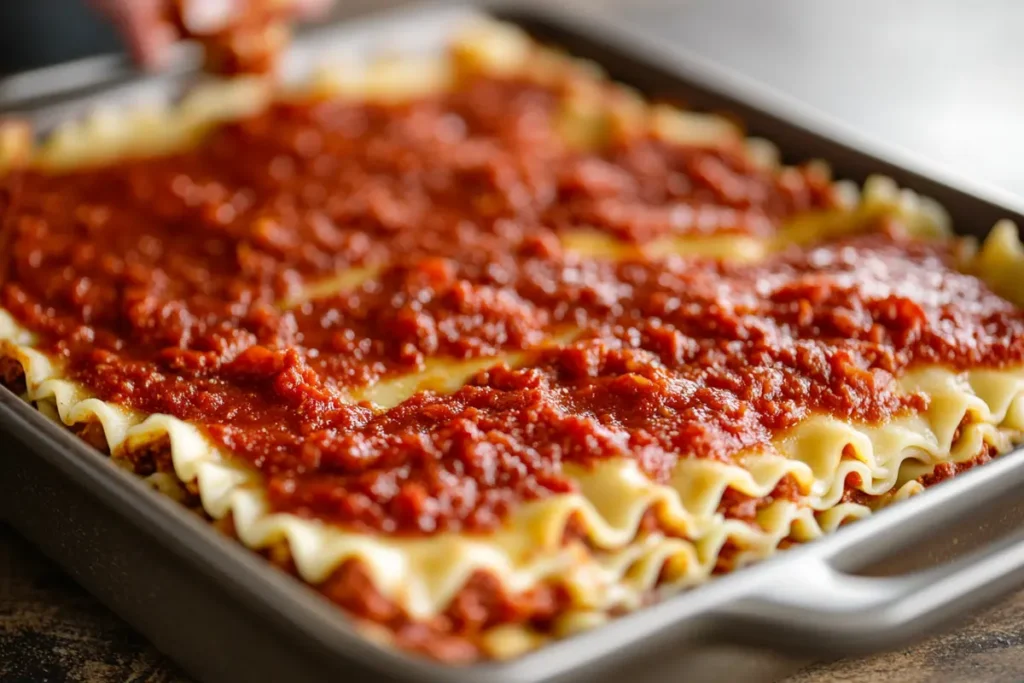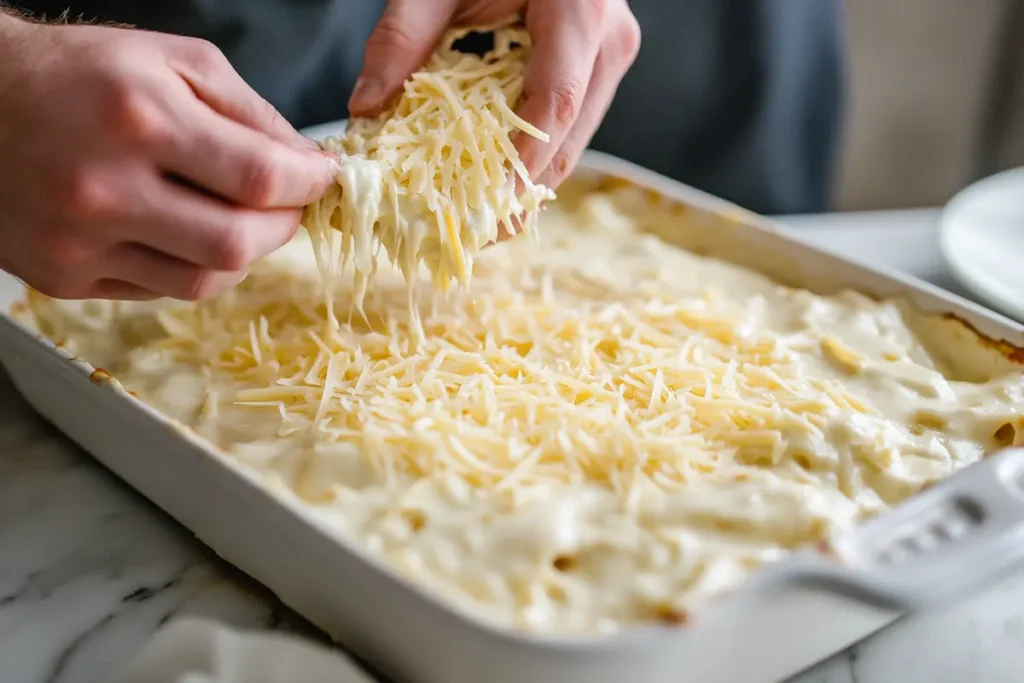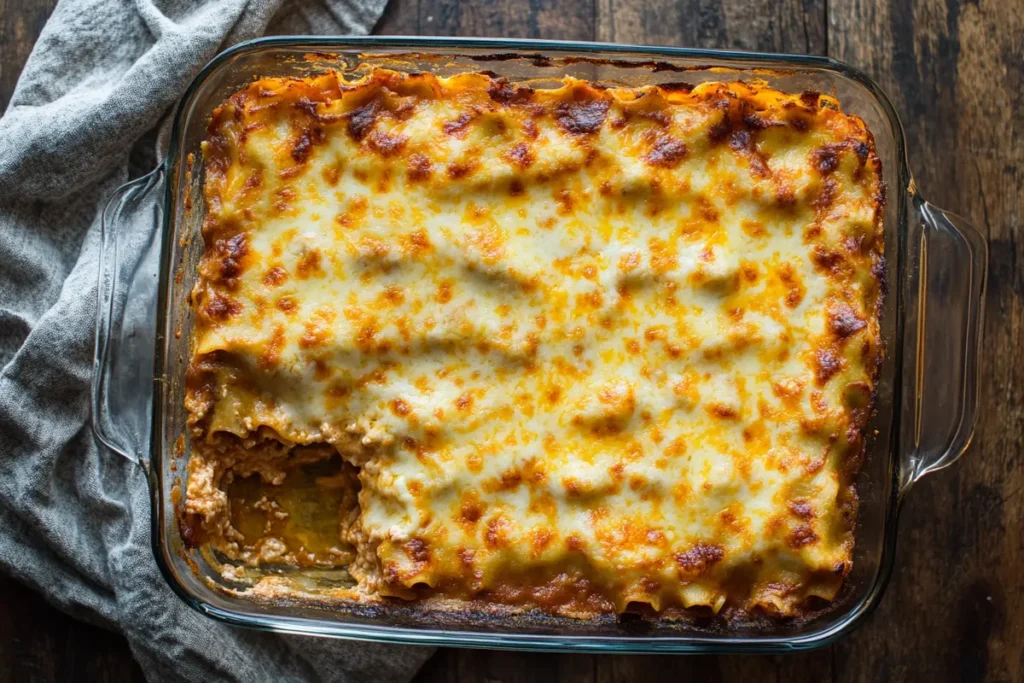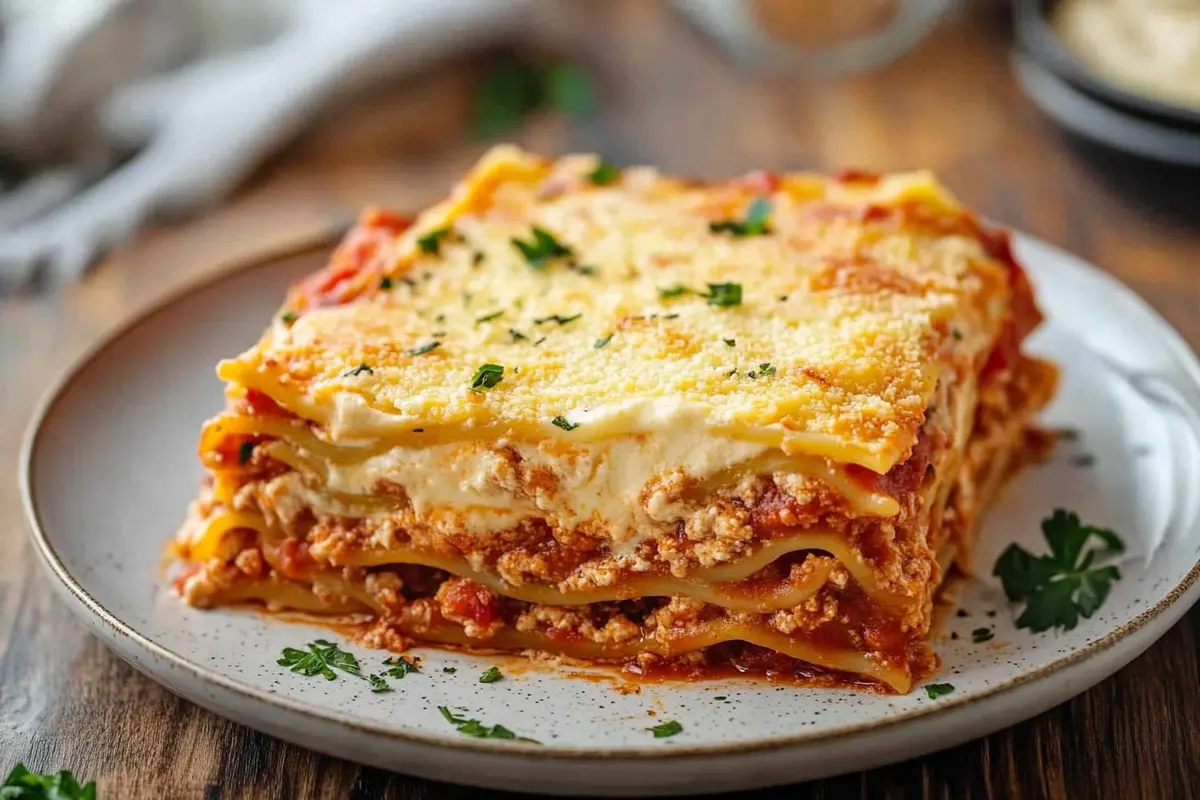Lasagna is more than just a comforting dish; it’s a culinary masterpiece. Its success hinges on the delicate balance of layers, which bring together bold flavors and contrasting textures. To create a lasagna that stands out, understanding the correct layers for lasagna is crucial. In this guide, you’ll discover the secrets of layering lasagna like a pro, from crafting savory sauces to assembling a flawless final product. By the end, you’ll be equipped to wow your guests or simply elevate your dinner game. Let’s dive into the world of perfectly layered lasagna!
Understanding the Art of Layering Lasagna
The Significance of Proper Layering in Lasagna
Proper layering in lasagna ensures every bite delivers a perfect balance of flavors and textures. It prevents soggy noodles, uneven cooking, or collapsing layers. The layering also enhances presentation, making the dish both delicious and visually appealing.
Historical Background of Lasagna
Originating in Italy’s Emilia-Romagna region, lasagna has evolved over centuries. Early versions used simple dough sheets and savory sauces, long before tomatoes arrived in Europe. Today, its layered structure remains a timeless culinary tradition, celebrated worldwide.
Essential Components of Lasagna
Key Ingredients for Traditional Lasagna
Creating a classic lasagna requires the perfect combination of ingredients. Each element plays a crucial role in achieving that delicious, comforting flavor we all crave. From hearty sauces to creamy cheeses and perfectly cooked noodles, every component must shine individually while contributing to the overall harmony of the dish.
The correct layers for lasagna depend on the thoughtful selection of quality ingredients. Let’s take a closer look at the building blocks of this culinary masterpiece.
Lasagna Noodle
Lasagna noodles are the structural backbone of the dish, providing layers that separate sauces and cheese. Traditional lasagna uses wide, flat pasta sheets, often boiled until al dente. However, no-boil noodles have become a convenient alternative, softening during baking.
High-quality noodles should be firm yet tender, allowing them to absorb flavors without becoming soggy. Whether homemade or store-bought, noodles act as a neutral base that complements the richness of sauces and cheese. For an authentic experience, opt for semolina-based pasta, as it holds up well in layered dishes.
Sauces
Lasagna is defined by its sauces, which provide moisture, flavor, and a luscious texture. A proper lasagna typically includes two main sauces: the hearty Bolognese and the creamy Béchamel.
Bolognese Sauce
Rich and savory, Bolognese sauce is a slow-cooked meat sauce made with ground beef, tomatoes, onions, and aromatic herbs. It forms the flavor-packed base of the lasagna, complementing the other layers beautifully.
Béchamel Sauce
This creamy white sauce adds smoothness to the dish, balancing the robustness of the Bolognese. Made with butter, flour, and milk, Béchamel creates a velvety texture that binds the layers together seamlessly.
Cheeses
Cheese is the crowning glory of lasagna, providing both flavor and structure. Most traditional recipes call for a blend of Ricotta and Mozzarella, which create the ultimate gooey and creamy texture.
Ricotta
Ricotta cheese, with its mild and slightly sweet flavor, is typically spread between layers to add creaminess. Its soft texture allows it to meld with the sauces effortlessly.
Mozzarella
Mozzarella, known for its melting properties, forms the golden, bubbly top layer of the lasagna. It brings a rich, cheesy finish that ties the dish together, offering both visual appeal and a satisfying bite.
Preparing Each Component
Crafting the Perfect Bolognese Sauce
A standout Bolognese sauce is the soul of a great lasagna, delivering depth and richness to the dish. Perfecting this meat sauce requires attention to detail, from choosing the right ingredients to letting it simmer to perfection. Here’s how to craft a sauce that elevates your lasagna to new heights.
Selecting Quality Meats
The foundation of any good Bolognese lies in the choice of meat. A mix of ground beef and pork works wonders, offering a balance of flavor and fat. Look for cuts with moderate fat content, as lean meat can make the sauce dry, while overly fatty options may feel too heavy.
For an authentic touch, opt for freshly ground meat from a butcher or grind it at home. The freshness enhances the flavor and texture of the sauce, giving it a heartier and more robust taste. Combining different meats creates a complex flavor profile that’s hard to beat.
Achieving the Ideal Consistency
Consistency is key to a Bolognese sauce that coats your lasagna layers perfectly. The sauce should be thick but not overly dry, allowing it to spread evenly without overwhelming the noodles.
To achieve this, cook the sauce slowly over low heat, letting the flavors meld and the liquid reduce gradually. Adding a splash of milk or cream during the cooking process helps to balance acidity while enhancing the creamy texture. Stir often to prevent sticking, and let time work its magic—Bolognese improves the longer it simmers.
Seasoning and Flavor Development
A well-seasoned Bolognese sauce is essential for achieving the correct layers for lasagna and making every bite unforgettable. Begin with aromatics like onions, garlic, and carrots, as these ingredients create a robust flavor foundation that enhances the lasagna layers. A pinch of nutmeg or a dash of oregano adds depth and a subtle warmth, perfectly complementing the other ingredients.
Season with salt and pepper gradually, ensuring the natural flavors of the sauce shine through without being overpowered. Adding tomato paste not only intensifies the sauce’s richness but also provides a savory base that ties the layers of lasagna together. A bay leaf can contribute a hint of earthiness, elevating the flavor profile. Patience is key—allow the sauce to simmer slowly until it reaches a harmonious blend of savory, sweet, and tangy notes, ensuring it’s the perfect addition to the correct lasagna layering.
Mastering Béchamel Sauce
While Bolognese brings boldness, Béchamel sauce provides the creaminess that makes lasagna irresistibly smooth. This versatile white sauce binds the layers and balances the dish’s hearty elements. Follow these steps to make a flawless Béchamel.
Essential Ingredients
The simplicity of Béchamel is its beauty. All you need are butter, flour, milk, and a touch of seasoning. Use unsalted butter to control the saltiness, and opt for whole milk for a creamier texture.
Nutmeg and white pepper are classic seasonings for Béchamel, adding subtle warmth and depth without overpowering the sauce. Fresh ingredients ensure a clean, delicate flavor that enhances the lasagna layers instead of competing with them.
Cooking Techniques for Smoothness
Achieving a silky Béchamel sauce requires careful technique. Start by melting butter in a saucepan, then whisk in flour to create a roux—a paste-like mixture that acts as the sauce’s thickening agent. Cook the roux for a minute or two to eliminate the raw flour taste, but don’t let it brown.
Gradually add warm milk while continuously whisking to prevent lumps. Keep the heat low and stir frequently until the sauce thickens to the consistency of heavy cream. If lumps form, don’t panic—simply strain the sauce through a fine sieve. A pinch of salt, white pepper, and nutmeg completes this velvety masterpiece.
Assembling the Lasagna
Step-by-Step Guide to Layering Lasagna
The magic of lasagna lies in its layers—each one meticulously crafted to create a balance of textures and flavors. Assembling a lasagna might seem daunting, but with this step-by-step guide, you’ll achieve perfection every time. Here’s how to create the correct layers for lasagna to ensure an evenly cooked, mouthwatering result.

Preparing the Baking Dish
Before layering begins, selecting and preparing the right baking dish is crucial. A deep rectangular dish made from glass or ceramic works best, as it provides even heat distribution and allows you to see the layers.
Lightly grease the bottom and sides of the dish with olive oil or non-stick spray to prevent sticking. Some chefs recommend a thin layer of sauce as the base to further ensure easy serving. Prepping your dish properly sets the stage for seamless layering and a clean presentation.
Layering Sequence
The secret to a perfect lasagna lies in its order of layers. This sequence ensures every bite is well-balanced and packed with flavor.
- First Layer: Sauce
Start by spreading a thin layer of Bolognese sauce on the bottom of the baking dish. This prevents the noodles from sticking and provides a flavorful foundation.
- Second Layer: Noodles
Lay down the first sheet of lasagna noodles, making sure they cover the sauce completely. Slightly overlap the edges if needed, but avoid excessive overlap to ensure even cooking.
- Third Layer: Bolognese Sauce
Spoon a generous layer of Bolognese sauce over the noodles, spreading it evenly. The meat sauce adds richness and depth to the dish.
- Fourth Layer: Béchamel Sauce
Drizzle a layer of creamy Béchamel sauce over the Bolognese. Its velvety texture binds the layers together and balances the robust flavors of the meat sauce.
- Fifth Layer: Cheese Mixture
Sprinkle an even mixture of Ricotta and Mozzarella cheese over the Béchamel. The Ricotta adds creaminess, while Mozzarella brings that melty, gooey perfection.

- Repeating Layers
Repeat the sequence—sauce, noodles, Bolognese, Béchamel, and cheese—until the dish is full. Aim for at least three complete sets of layers, finishing with cheese on top for a golden, bubbly crust.
Topping the Lasagna
The final topping seals the deal. Cover the topmost layer with a generous helping of shredded Mozzarella cheese. For extra flair, add a sprinkle of grated Parmesan and a pinch of Italian herbs like oregano or basil.
To prevent burning, cover the dish with foil for the first half of baking, then uncover it to allow the cheese to brown beautifully. This step guarantees an irresistible golden crust that crowns your perfectly layered lasagna.
Baking and Serving
Optimal Baking Techniques for Lasagna
Getting the correct layers for lasagna to bake evenly and taste perfect requires more than just following a recipe—it’s about timing, temperature, and proper preparation. These techniques will help you bake a lasagna that’s flavorful, perfectly structured, and irresistible.
Preheating the Oven
Preheating is essential to ensure the correct layers for lasagna bake evenly. Set your oven to 375°F (190°C) and wait until it’s fully preheated. An evenly heated oven ensures the noodles, sauces, and cheese cook simultaneously for a cohesive dish.

Baking Time and Temperature
The correct layers for lasagna need about 45–60 minutes to bake to perfection. For the first 30 minutes, cover the dish with aluminum foil to lock in moisture and allow the noodles to soften. Removing the foil for the last 15–20 minutes lets the top layer of cheese brown beautifully, giving the lasagna a golden crust.
To check if your lasagna is fully cooked, insert a thermometer into the center. The perfectly baked lasagna should reach an internal temperature of 165°F (74°C).
Resting Period Before Serving
Once baked, letting the lasagna rest for 15–20 minutes is crucial. This step allows the correct layers for lasagna to set, ensuring clean slices and preventing the fillings from spilling out. Skipping the resting period can result in a messy dish, no matter how well-layered it was.
Serving Suggestions
To complement the correct layers for lasagna, serve it with fresh sides like a crisp Caesar salad or roasted vegetables. Add a sprinkle of fresh herbs like basil or parsley for a vibrant finishing touch. Garlic bread pairs perfectly, soaking up every last drop of sauce.
Variations and Tips
Exploring Lasagna Variations
The versatility of lasagna makes it a favorite for many. Whether you’re adjusting for dietary needs or experimenting with flavors, there are countless ways to make the correct layers for lasagna your own. Let’s dive into some creative variations that honor this classic dish while offering unique twists.
Vegetarian Lasagna Options
To create a vegetarian version with the correct layers for lasagna, swap Bolognese sauce for a hearty marinara packed with roasted vegetables. Zucchini, spinach, mushrooms, and bell peppers bring flavor and texture. For added protein, consider layers of lentils or chickpeas. This variation maintains the essence of lasagna while catering to plant-based preferences.
Gluten-Free Lasagna Alternatives
For those avoiding gluten, achieving the correct layers for lasagna is still possible. Replace traditional noodles with gluten-free options made from rice, quinoa, or lentil flour. You can also use thin slices of zucchini or eggplant as a substitute, maintaining structure while adding a fresh, low-carb twist.
Incorporating Different Cheeses
The correct layers for lasagna can shine with diverse cheese selections. Swap Ricotta for mascarpone for a rich texture, or try Gruyère, Fontina, or Gouda for unique flavors. Adding sharp Cheddar to the top layer creates a golden crust with a delightful tang, giving your lasagna a new level of indulgence.
Common Mistakes to Avoid
Even with the best intentions, missteps can disrupt the correct layers for lasagna. Here are tips to avoid common mistakes and ensure your dish turns out perfectly.
Preventing Soggy Lasagna
To avoid soggy lasagna layers, ensure your sauces are properly thickened. Drain cooked noodles thoroughly, and pat down vegetables to remove excess moisture. These steps help preserve the integrity of your lasagna’s layers during baking.
Ensuring Even Cooking
For evenly cooked lasagna, ensure the correct layers for lasagna are consistent in thickness. Spread fillings evenly and cover the dish with foil for the first half of baking to prevent overcooked edges or an undercooked center. This technique guarantees each layer cooks uniformly.
Frequently Asked Questions
FAQs About Lasagna Layering
Lasagna is a beloved dish, but its preparation often raises questions. Whether you’re a seasoned cook or a beginner, understanding the nuances of lasagna layering can help you achieve culinary success. Here are answers to some commonly asked questions.
How many layers should a lasagna have?
While there’s no hard-and-fast rule, most traditional lasagnas have three to five layers. The number depends on the depth of your baking dish and the ingredients used.
Aim for at least three full sets of layers (sauce, noodles, fillings), finishing with a cheese topping. More layers enhance the flavors but require careful assembly to prevent the dish from collapsing.
What is the correct order to layer lasagna?
The correct layers for lasagna follow this sequence: start with sauce, add noodles, then alternate between fillings (Bolognese, Béchamel, and cheese). Repeat until you reach the top layer, which should be cheese for a golden crust.
This order ensures the noodles remain moist, the fillings are evenly distributed, and the dish holds its structure during baking.
Should the top layer of lasagna be noodles or sauce?
The top layer should never be noodles alone. Instead, finish with a combination of sauce and cheese. This prevents the noodles from drying out during baking and creates a beautifully browned, bubbling surface.
For the best results, sprinkle shredded Mozzarella and Parmesan generously over the sauce for a visually appealing and delicious topping.
How long should lasagna rest before serving?
Lasagna should rest for 15–20 minutes after baking. This allows the layers to set, making it easier to cut clean slices and serve without the fillings spilling out.
Resting also enhances the flavor, as the ingredients have time to meld together. While it’s tempting to dig in right away, a brief wait can make all the difference.
Conclusion
Mastering the correct layers for lasagna is the key to creating a dish that’s flavorful, balanced, and visually stunning. From selecting the best ingredients to perfecting sauces and assembling layers thoughtfully, every step matters. Whether you stick to tradition or experiment with new variations, lasagna is a versatile dish that always delivers comfort and satisfaction. Now, it’s your turn to layer, bake, and enjoy this classic favorite!

